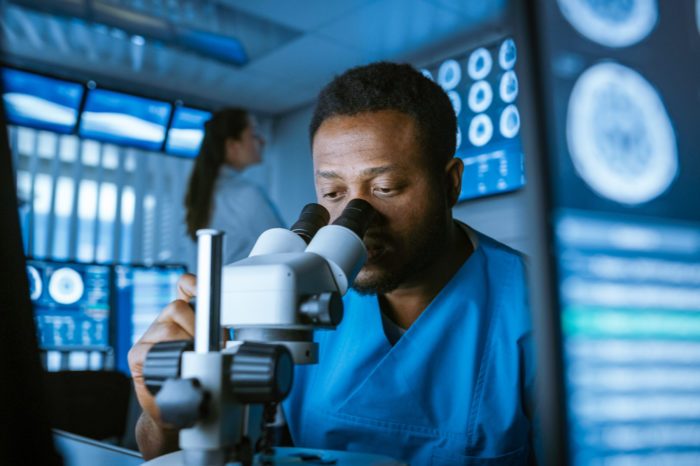Here’s how the endocannabinoid system and its many of receptors works.
The endocannabinoid system refers to a signaling system of receptors on the surface of certain body cells. It includes ligands, or endocannabinoids, that fit into the receptors and activate them. Also included in this system are enzymes responsible for making or degrading the endocannabinoids.
In the 1980s, scientists began researching the brain and the effect of cannabinoids in the cannabis plant. This is when we learned that there are specific binding sites for cannabinoids. Then in the early 1990s, scientists identified and cloned two major cannabinoid receptors. These are CB1 and CB2 and are both are G protein receptors.
Since their discovery, researchers have learned more about the endocannabinoid system and mechanisms for its involvement in various diseases. As a result, cannabis, or cannabinoids, have become the focus of developing new therapies, and the medical use of cannabis has become a target of public policy.

CB1 Receptors in Endocannabinoid System
The first type of cannabinoid receptor, CB1, is found primarily in the brain and on tissues associated with the central nervous system, like neurons in the spinal cord. However, it has also appears in peripheral organs like the pancreas, digestive tract, and liver.
In the brain, CB1 receptors are present in high densities in certain structures, like the substantia nigra, basal ganglia, cerebellum, and hippocampus. Other areas of the brain have much lower densities, like the brainstem, which is why cannabis can’t be lethal; it doesn’t affect respiratory centers in the brain.
CB1 receptors are most likely responsible for the psychoactive effects of cannabis. These receptors also play an important role in brain development and in several signaling pathways in the brain. These pathways are responsible for: cognition, neuronal growth, and the regulation of reward and mood systems. Activation of the CB1 receptor is therefore not only responsible for the euphoric high associated with the recreational use of Cannabis but also for a variety of therapeutic effects like treating anxiety, pain, and post-traumatic stress disorder (PTSD).

What Activates The CB1 Receptor?
Our body naturally produces ligands which activate the CB1 receptor. However, the most famous of all the cannabinoids, delta-9-tetrahydrocannabinol (THC) activates it. THC binds strongly to the CB1 receptor, which is likely the reason for its psychoactive effects.
Cannabidiol (CBD) can bind to the CB1 receptor, but not very strongly; its affinity for the receptor is low. Another cannabinoid found in the cannabis plant is delta-9-tetrahydrocannabivarin (THCV). This cannabinoid also binds strongly to the CB1 receptor. THCV, though, blocks the binding site on the CB1 receptor, inhibiting its activation. So, it’s medicinal actions are different than THC.
In the brain, the CB1 receptor often appears neural synapses. But, unlike the receptors associated with most neurotransmitters, the CB1 receptor is often found in the presynapse neuron. The postsynaptic neuron creates and releases cannabinoids. When the CB1 receptor activates, it often prevents further release of neurotransmitters. This means that the endocannabinoid system functions as a negative feedback loop. For example, it can prevent the release of glutamate. Thsi couls be how cannabis has a neuroprotective effect.
CB2 Receptor is Part of Immune System
The CB2 receptor is primarily expressed by immune cells. Some scientists hypothesize that the CB2 receptor evolved as a defense mechanism for the body since it is involved in suppressing inflammatory responses and in neuroprotective responses to brain injury.
Scientists also believe the CB2 receptor connects to the pain relieving use of cannabis. THC and CBD both bind to the CB2 receptor, although again, CBD has a low affinity for it. THCV also inhibits the CB2 receptor, just as it does for the CB1 receptor. Many researchers have developed synthetic cannabinoid molecules that can bind specifically to the CB2 receptor and not to the CB1 receptor in order to obtain therapeutic effects of CB2 activation without causing psychoactive side effects.
The low affinity of CBD for both the cannabinoid receptors causes some researchers to hypothesize that there may be other, as yet unknown receptors in the endocannabinoid system. Other receptors that couple with G Proteins are also cannabinoid-like.

Other Receptors
In addition to Endocannabinoid receptors, there are other receptors in our bodies. These include the transient receptor potential vanilloid type 1 receptor (TRPV1) ion channel, that cannabinoids like CBD activate. This means there may be some crossover between the endocannabinoid and other signaling systems.
Scientists also believe CBD inhibits the activity of fatty acid amide hydrolase (FAAH). This is the enzyme responsible for breaking down the endocannabinoid anandamide. As a result, CBD contributes to elevated levels of anandamide, which targets the cannabinoid receptors with higher affinity than CBD but without the psychoactive effects of THC.
There is no doubt that we are at the beginning of a very exciting learning curve for medicine. Science learns more about how cannabis interacts with the endocannabinoid receptors in our body. Soon we will develop strains that target specific conditions.





